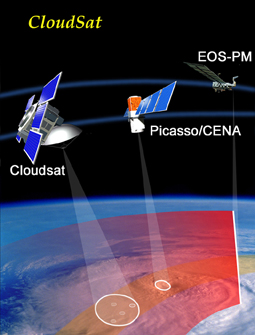
![]()
Home | Crosswords | Word Searches | Flash Cards | Verbs | Songs | Creative Writing | Work Sheets | Phonics | ABCs Potion Book | Spell Book | ESL for Adults | Ask Thomas | Lesson Plans | Scott Foresman ESL | Jobs | Web Guide
Cloudsat: Scanning the Clouds
Sometimes they look like billowy, white marshmallows. Other times they look like wispy, thin feathers. Clouds change from one minute to the next.
It's nice that clouds are so interesting to watch, but they have a much more important job. They are the water transportation system of the world! Without clouds, all the water would eventually end up in the oceans, with none left for lakes, rivers, or streams.

Cloudsat is a satellite that NASA will launch in 2003. It will take 3-D pictures of clouds.
Clouds are made when water from Earth's surface evaporates into the sky. This means that as the sun warms the surface of the ocean or the land, water on the surface turns from a liquid to a gas and rises into the air. As the warm, moist air rises, it cools off. As it cools, the water gas turns again to droplets of liquid water. The droplets stick together and make bigger droplets. Finally, they get too heavy to remain in the cloud and they fall out as rain. If it's very cold, they freeze into solid form, and fall as snow or hail.
Meantime, the winds may have carried the water in the cloud a long way from where it first came off the surface of the ocean or the land. However, no matter how much water they dump out, clouds do not give the Earth any more water than it had before. The total water on Earth stays the same all the time. Clouds work very hard just moving the water around, from one place to another.
Cloudsat is a new spacecraft that will be launched in 2003 to study the clouds. It will use radar to take 3-D pictures of clouds and measure how much water and ice are in them at different heights. Cloudsat will work with other satellites that take different kinds of cloud measurements. Data collected by all these satellites will help scientists understand better how clouds work and how they affect climate all over the world.
Learn 'cloudspeak' and do the cloud picture scramble on The Space Place at http://spaceplace/cloudsat_puz.htm
The Space Place is a web site for children with fun and educational activities and facts related to many of NASA's space missions. This article was provided by NASA's Jet Propulsion Laboratory, managed by Caltech in Pasadena. Republished on Lanternfish with permission.